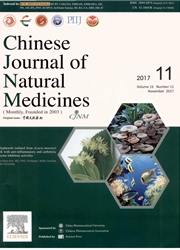

 中文摘要:
中文摘要:
Amphibian skin contains rich bioactive peptides. Especially, a large amount of antimicrobial peptides have been identified from amphibian skin secretions. Antimicrobial peptides display potent cytolytic activities against a range of pathogenic bacteria and fungi and play important defense roles. No antimicrobial peptides have been reported from toads belonging to the family of Pelobatidae. In this work, two novel antimicrobial peptides(Megin 1 and Megin 2) were purified and characterized from the skin venoms of spadefoot toad Megophrys minor(Pelobatidae, Anura, Amphibia). Megin 1 had an amino acid sequence of FLKGCWTKWYSLKPKCPF-NH2, which was composed of 18 amino acid residues and contained an intra-molecular disulfide bridge and an amidated C-terminus. Megin 2 had an amino acid sequence of FFVLKFLLKWAGKVGLEHLACKFKNWC, which was composed of 27 amino acid residues and contained an intra-molecular disulfide bridge. Both Megin 1 and Megin 2 showed potential antimicrobial abilities against bacteria and fungi. The MICs of Megin 1 against Escherichia coli, Bacillus dysenteriae, Staphylococcus aureus, Bacillus subtilis, and Candida albicans were 25, 3, 6.25, 3, and 50 μg·m L-1, respectively. The corresponding MICs for Megin 2 were 6.25, 1.5, 12.5, 1.5, and 12.5 μg·m L-1, respectively. They also exerted strong hemolytic activity against human and rabbit red cells. The results suggested that megin peptides in the toad skin of M. minor displayed toxic effects on both eukaryotes and prokaryotes. This was the first report of antimicrobial peptides from amphibians belonging to the family of Pelobatidae.
 英文摘要:
英文摘要:
Amphibian skin contains rich bioactive peptides. Especially, a large amount of antimicrobial peptides have been identified from amphibian skin secretions. Antimicrobial peptides display potent cytolytic activities against a range of pathogenic bacteria and fungi and play important defense roles. No antimicrobial peptides have been reported from toads belonging to the family of Pelobatidae. In this work, two novel antimicrobial peptides (Megin 1 and Megin 2) were purified and characterized from the skin venoms of spadefoot toad Megophrys minor (Pelobatidae, Anura, Amphibia). Megin 1 had an amino acid sequence of FLKGCWTKWYSLKPKCPF-NH2, which was composed of 18 amino acid residues and contained an intra-molecular disulfide bridge and an amidated C-terminus. Megin 2 had an amino acid sequence of FFVLKFLLKWAGKVGLEHLACKFKNWC, which was composed of 27 amino acid residues and contained an intra-molecular disulfide bridge. Both Megin 1 and Megin 2 showed potential antimicrobial abilities against bacteria and fungi. The M1Cs of Megin 1 against Escherichia coli, Bacillus dysenteriae, Staphylococcus aureus, Bacillus subtilis, and Candida albicans were 25, 3, 6.25, 3, and 50 μg.mL-1, respectively. The corresponding MICs for Megin 2 were 6.25, 1.5, 12.5, 1.5, and 12.5 μg.mL -1, respectively. They also exerted strong hemolytic activity against human and rabbit red cells. The results suggested that megin peptides in the toad skin of M. minor displayed toxic effects on both eukaryotes and prokaryotes. This was the first report of antimicrobial peptides from amphibians belonging to the family of Pelobatidae.
 同期刊论文项目
同期刊论文项目
 同项目期刊论文
同项目期刊论文
 期刊信息
期刊信息
